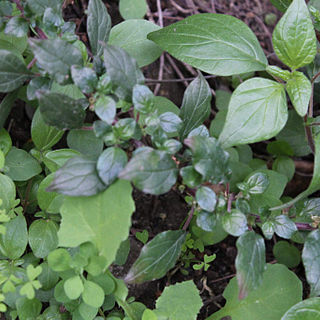Polygamous annual herb; stems erect or sometimes ascending, covered in curved and hooked hairs, sometimes also scattered glandular and flexuose hairs. Leaves: lamina ovate to broadly ovate, entire, obtuse, blunt or obtusely acuminate at apex, cuneate, rounded, subcordate or truncate at base, (0.5–) 1–3.5 (–5) cm long, 0.4–2 cm wide (to 4.5 cm wide reported by Green 1994), sparsely pubescent to ± glabrous, lateral veins in 3 pairs, the basal pair prominent; petiole 1–2 (–3) cm long. Inflorescence a few-flowered sessile cymule or cluster, the lower axils mainly female, the upper mixed male, female and bisexual; lateral flowers subtended and partially concealed by involucre of 3 bracts, the bracts unequal, free or basally united, usually lanceolate to ovate, with a simple or branched distinct midvein, a delicate reticulate venation sometimes visible, green and soft at maturity. Male flowers subsessile, c. 1 mm long. Female flowers c. 2 mm long; perianth 4-dentate; ovary ellipsoidal to ovoid; stigma subsessile, subcapitate, with long stigmatic processes. Lateral flowers long-pedicellate in fruit. Achenes ellipsoidal, c. 2 mm long [compressed-ovoid, 1–1.5 mm long, fide Green 1994: 71; 1.2–1.4 mm long, fide Gebauer 1996: 87], smooth, enclosing perianth, brown-ribbed.
Annual herb. Stems prostrate, delicate, sometimes rooting at nodes, glabrous or with short stiff hairs, sometimes with stalked glands when young, stinging hairs absent. Leaves broadly ovate to broader than long, 5-30 x 3-23 mm, apex obtuse or slightly obtuse-acuminate, base truncate to slightly cordate, margin entire, glabrous or with short stiff hairs, hairs denser along veins and margin, sometimes with long curved hairs intermixed; petiole glabrous or with curved stiff hairs. Inflorescence of 1-few sessile or shortly pedicellate flowers in leaf axils, with male, female and bisexual intermix d. Flowers with bracts having glandular hairs and long curved hairs. Female flowers 4-merous, shortly pedicellate; perianth ±0.5 x 1.5 mm long, with minute hairs on outer surface. Bisexual flowers with perianth with short hairs on outer surface, ±1 mm long. Male flowers subsessile, 4-merous, up to 1.5 mm in diameter. Achenes ±1.5 mm long, smooth, shiny, dark brown.
Annual herb, 0.17-0.45 m high; nonstinging hairs. Leaves alternate, broadly ovate, glabrous or stiff hairs on veins and margins, base subcordate to truncate, apex obtuse or acute, margins entire; petioles glabrous. Inflorescence in leaf axils, pedicellate. Flowers with bracts, bisexual or unisexual. Female flowers 4-merous; perianth ± 0.5 x 1.5 mm long; stigma linear. Male flowers 4-merous, subsessile, up to 1.5 mm in diam. Bisexual flowers ± 1 mm long; perianth with short hairs on outside. Flowering time Nov.-Jan. Fruit smooth achenes, dark brown, ovoid, shiny, stipitate.
Diffuse annual, sparsely pubescent, flaccid herb; branches slender, weak, hardened at base, up to 3 dm. or more long. Lvs membr., thin or sts subsucculent in coastal forms, 1-4 × 1-2.5 cm., on almost filiform petioles up to 3 cm. long, us. with accessory smaller lvs; lamina broad-to rhomboid-ovate with cuneate base, obtuse to obtusely attenuate at apex. Cymes congested, 2-8-fld; bracts linear; per.-segs ± pilose, pistillate enlarged in fr. Achenes 1-1·5 mm. long, ovoid, dark brown, glossy.
Annual, occasionally perennial, herb, 0.17-0.45 m high. Stems procumbent, delicate. Leaves with blades broadly ovate, 5-30 x 3-23 mm, apex ± obtuse, margins entire. Flowers: 1-few in leaf axils, male, female and bisexual intermixed; bracts with unbranched, glandular hairs and long curved, unbranched standard hairs. Fruit ± 1.5 mm long, smooth, glabrous, shiny, dark brown.
Slender, diffuse, hairy annual. Stem succulent, up to 70 cm long, often lax. Lvs midgreen, sometimes shiny, thin and delicate, rhombic-ovate, up to 5 cm long. Petioles often = or > lamina. At least some bracteoles > perianth at fruiting. Achenes ovoid, dark brown, 1-1.5 mm long.
A herb.

